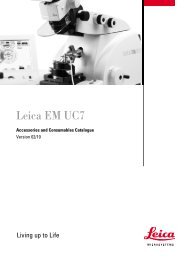Physical Principles of Electron Microscopy: An Introduction to TEM ...
Physical Principles of Electron Microscopy: An Introduction to TEM ...
Physical Principles of Electron Microscopy: An Introduction to TEM ...
Create successful ePaper yourself
Turn your PDF publications into a flip-book with our unique Google optimized e-Paper software.
48 Chapter 2<br />
So far, we have said nothing about the value <strong>of</strong> the spherical-aberration<br />
coefficient Cs. On the assumption <strong>of</strong> a Lorentzian (bell-shaped) field, Cs can<br />
be calculated from a somewhat-complicated formula (Glaeser, 1952). Figure<br />
2.13 shows the calculated Cs and focal length f as a function <strong>of</strong> the maximum<br />
field B0, for 200kV accelerating voltage and a field half-width <strong>of</strong> a = 1.8 mm.<br />
The thin-lens formula, Eq. (2.9), is seen <strong>to</strong> be quite good at predicting the<br />
focal length <strong>of</strong> a weak lens (low B0) but becomes inaccurate for a strong<br />
lens. For the weak lens, Cs � f � several mm; but for a strong lens (B0 = 2 <strong>to</strong><br />
3 T, as used for a <strong>TEM</strong> objective), Cs falls <strong>to</strong> about f / 4. If we take f = 2 mm,<br />
so that Cs � 0.5 mm, and require a point resolution rs = 1 nm, the maximum<br />
angle <strong>of</strong> the electrons (relative <strong>to</strong> the optic axis) must satisfy: Cs� 3 � rs ,<br />
giving ��� 10 -2 rad = 10 mrad. This low value justifies our use <strong>of</strong> smallangle<br />
approximations in the preceding analysis.<br />
lens parameter (in mm)<br />
10.0<br />
5.0<br />
2.0<br />
1.0<br />
0.5<br />
thin-lens f<br />
actual f<br />
Cs<br />
C c<br />
0.2<br />
0 1 2 3 4<br />
B 0 (Tesla)<br />
Figure 2-13. Focal length and coefficients <strong>of</strong> spherical and chromatic aberration for a<br />
magnetic lens containing a Lorentzian field with peak field B0 and half-width a = 1.8 mm,<br />
focusing 200keV electrons. Values were calculated from Eq. (2.7) and from Glaeser (1952).<br />
10.0<br />
1.0



